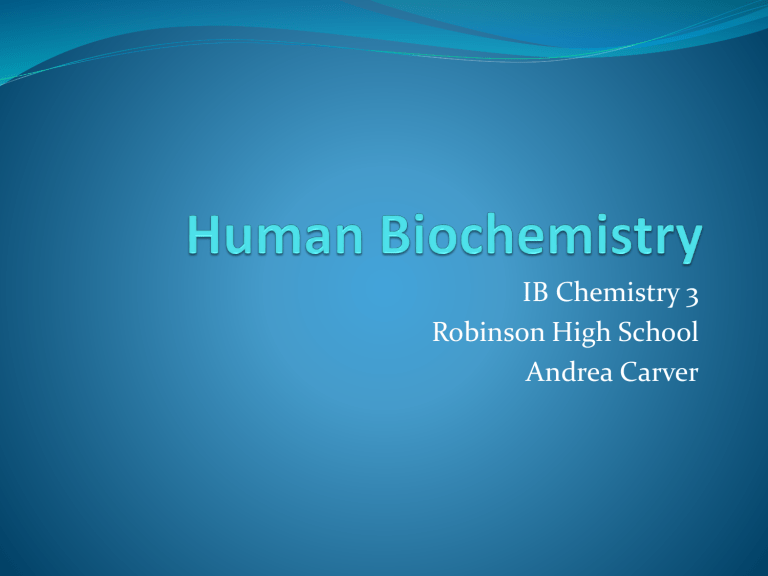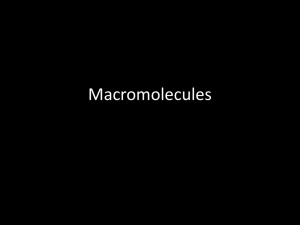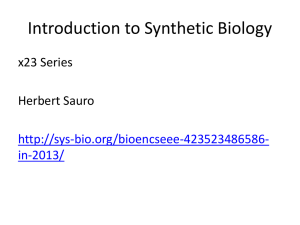
IB Chemistry 3
Robinson High School
Andrea Carver
Biochemistry is…
The study of the chemical processes occurring in living
organisms.
Includes processes involving the flow of both energy
and information.
Deals with biomolecules such as proteins,
carbohydrates, lipids, and nucleic acids.
Energy: IB Objectives
B.1.1 Calculate the energy value of a food from enthalpy
of combustion data.
Energy
Every living cell contains thousands of biological
molecules each of which is involved in the interlinked
processes of metabolism.
Cellular respiration is the oxidative process by which
energy stored in food is made available for use by the
cell.
O2
Starch
Protein
Rxns of Respiration
Glucose
Glycogen
Fats
Energy
CO2 + H2O
Measuring Energy Production
Combustion analysis is used to determine the amount
of energy produced from a unit of a particular food.
A bomb calorimeter measures the heat of
combustion of a reaction.
Food is burned within the calorimeter, and heat
released raises the temperature of a known quantity of
water.
Calculation of Energy Release
Formula: q=mc∆T
q= the energy evolved (J)
m= the mass of water (g)
c= the specific heat of water (4.18 J/g•K)
∆T= the temperature change of water (K)
Example: A 0.78 food sample combusts raising the
temperature of 105.10 g water from 15.4°C to 30.6°C.
Calculate the energy value of food in kJ/g.
Proteins: IB Objectives
B.2.1 Draw the general formula of 2-amino acids.
B.2.2 Describe the characteristic properties of 2-amino
acids.
B.2.3 Describe the condensation reaction of 2-amino acids
to form polypeptides.
B.2.4 Describe and explain the primary, secondary (alpha
helix and beta pleated sheets), tertiary , and quaternary
structure of proteins.
B.2.5 Explain how proteins can be analyzed by
chromatography and electrophoresis.
B.2.6 List the major functions of proteins in the body.
Proteins: Function
Structure- Proteins make up many diverse protective,
contractile, and supporting structures in the body.
Examples: keratin, collagen, myosin, immunoproteins,
hemoglobin, casein, mucoproteins
Tools- Proteins are valuable operators on the
molecular level such as enzymes and hormones.
Examples: lactase, insulin
Proteins: Structure
Amino Acids are the building blocks of proteins.
Amino Acids
2-amino acids- Numbering begins with carbonyl
carbon and R group is bound to carbon 2.
Carbon 2 is also bound to H, NH2, and COOH.
R group- defines the amino acid. Amino acids can be
classified by the chemical nature of this group (nonpolar, polar, basic, acidic).
20 amino acids occur naturally.
Characteristics of Amino Acids
Crystalline, high melting points, greater solubility in water
than in non-polar solvents.
Exist as dipolar ions- contain both positive and negative
charges- zwitterions.
Amphoteric- can react as both an acid and a base.
Amino acids can act as buffers.
Isoelectric Point
This is the pH at which the amino acid is electrically
neutral (typically when the amino acid is a zwitterion).
Condensation of Amino Acids
Amino acids link together through condensation reactions
to form proteins.
Condensation reaction- H2O is eliminated as a new bond
is formed.
Forms a peptide bond.
Two amino acids combine to form a dipeptide.
Three amino acids combine to form a tripeptide.
More amino acids combine to form a poly peptide.
The sequence of linked amino acids will determine the
nature of the polypeptide=> variety of proteins (millions of
possibilities).
Structure of Proteins
Primary Structure-Number and sequence of amino
acids in polypeptide chain.
Secondary Structure- Folding of polypeptide chain
due to hydrogen bonding between peptide groups.
Tertiary Structure- Further twisting, folding of the
chain due to interactions between R-groups (side
chains).
Quaternary Structure- Association between more
than one polypeptide subunit.
Primary Structure
Forms covalent backbone of molecule.
Held together by peptide bonds.
All other levels of structure determined by primary
structure.
What determines primary structure of a protein?
Secondary Structure
Two main types:
Beta pleated sheets
“side by side” polypeptides
Pleated sheets cross-linked
Inter-chain H-bonds
Flexible, but inelastic
Alpha helix
Regular, coiled
Flexible and elastic
Intra-chain H-bonds
H-bonds four AA’s apart
Tertiary Structure
Determines protein’s conformation.
Important for function of enzymes, hormones, etc.
Most stable arrangement accounting for all possible
interactions between side chains.
Possible Interactions:
Hydrophobic Interactions
Hydrogen Bonding
Ionic Bonding
Disulfide Bridges
Quaternary Structure
The association of more than one chain in proteins.
Analysis of Proteins
First, amino acid composition can be determined by
hydrolyzing the peptide bonds which link together
amino acids in the polypeptide chain.
Specific linkages can be hydrolyzed using certain
enzymes.
Then peptides can be separated based on differences
in size and charge using the following techniques.
Chromatography
Electrophoresis
Chromatography
Amino acids are treated with a locating
reagent to colorize them.
A small amount of the mixture is placed at
the origin.
Stationary Phase- does not move (paper)
Mobile Phase- travels taking some sample
with it (solvent)
Movement of peptide fragments
determined by size.
Rf= distance traveled by amino acid
distance traveled by solvent
Specific amino acids have characteristic Rf
values.
Electrophoresis
Separates amino acids based on movement
of charged particles.
A charge gradient is established on a gel.
Proteins migrate based upon charge of side
chains present.
Proteins settle near their isoelectric points.
Carbohydrates: IB Objectives
B.3.1 Describe the structural features of monosaccharides.
B.3.2 Draw the straight chain and ring structural formulas
of glucose and fructose.
B.3.3 Describe the condensation of monosaccharides to
form disaccharides and polysaccharides.
B.3.4 List the major functions of carbohydrates in the
human body.
B.3.5 Compare the structural properties of starch and
cellulose, and explain why humans can digest starch but
not cellulose.
B.3.6 State what is meant by the term dietary fiber.
B.3.7 Describe the importance of a diet high in dietary
fiber.
Carbohydrates
Carbohydrates: Functions
Carbohydrate Structure
Monosaccharides
Monosaccharides:
Straight-Chain Forms
Monosaccharides:
Ring Structures
Disaccharides
Polysaccharides
Starch
Glycogen
Cellulose
Digestion of Polysaccharides
Dietary Fibre
Lipids: IB Objectives
B.4.1 Compare the composition of the three types of lipids found in the human
body.
B.4.2 Outline the difference between HDL and LDL cholesterol and outline its
importance.
B.4.3 Describe the difference in structure between saturated and unsaturated
fatty acids.
B.4.4 Compare the structures of the two essential fatty acids, linoleic (omega-6
fatty acid) and linolenic (omega-3 fatty acid) and state their importance.
B.4.5 Define the term iodine number and calculate the number of C=C double
bonds in an unsaturated fat/oil using addition reactions.
B.4.6 Describe the condensation of glycerol and three fatty acid molecules to
make a triglyceride.
B.4.7 Describe the enzyme catalyzed hydrolysis of triglycerides during
digestion.
B.4.8 Explain the higher energy value of fats compared to carbohydrates.
B.4.9 Describe the important roles of lipids in the body and the negative effects
that they can have on health.
Lipids
Lipids: Characteristics
Hydrophobic, insoluble in water
Soluble in non-polar solvents
Contain Carbon, Hydrogen, and Oxygen
Less oxidized than carbohydrates (more H, less O)
Include fats, oils, steroids, and phospholipids
Functions:
Energy Storage
Insulation
Protection of Organs
Absorption of Fat Soluble Vitamins (A,D,E,K)
Structural-Membrane Component
Myelin Sheaths of Axons
Negative Effects of Lipids
•Excess lipids are stored in the
body as adipose tissue.
•Sometimes excess lipids are
deposited into the walls of arteriesAtherosclerosis.
•Atherosclerosis (aka hardening of
the arteries) can lead to
hypertension , stroke, and
myocardial infarction.
•The image shows the aorta of an
individual with atherosclerosis.
Cholesterol: Good or Bad?
Cholesterol is insoluble in blood, so it is transported as
lipoproteins: HDL and LDL.
LDL- “bad cholesterol”
HDL- “good cholesterol”
Lipid Structure
Three main types:
Triglycerides
Phospholipids
Steroids
Triglycerides
Fatty Acids: Saturation
Saturated fatty acids have no double bonds.
Mono-unsaturated fatty acids have one double bond.
Polyunsaturated fatty acids have more than one double
bond.
Essential Fatty Acids
Some fatty acids cannot be synthesized by the body
and must be obtained from the diet. These are
essential fatty acids.
Linoleic acid (omega-6)
Linolenic acid (omega-3)
Iodine Number
Determination of the number of double bonds in a
fatty acid based upon its reactivity with iodine.
Iodine can add to formerly double bonded carbons
(addition reaction).
The iodine number is the number of grams of iodine
which can react with 100 grams of fat.
Digestion of Fats
Lipases digest fat via hydrolysis reactions.
Structure: Steroids
Micronutrients & Macronutrients:
IB Objectives
B.5.1 Outline the difference between micronutrients
and macronutrients.
B.5.2 Compare the structures of retinol (vitamin A),
calciferol (vitamin D), and ascorbic acid (vitamin C).
B.5.3 Deduce whether a vitamin is water or fat soluble
from its structure.
B.5.4 Discuss the causes and effects of nutrient
deficiencies in different countries and suggest
solutions.
Nutrients
Nutrients are necessary for the body and must be
obtained from the diet.
Recommended Daily Intake is the amount of a
given nutrient which must be consumed each day.
Macronutrients- nutrients required in large amounts
Micronutrients- nutrients required in extremely small
amounts
Vitamins
Vitamins are organic compounds required in small amounts by
the body.
These compounds must be obtained from the diet.
Categorized by solubility:
Fat Soluble Vitamins
A, D, E, & K
Non-polar molecules, hydrocarbon chains or rings
Slower absorption
Excess can be stored in fat which can be pathological
Water Soluble Vitamins
C
Polar bonds, can hydrogen bond
Transported directly in blood
Excess can be removed by the kidney
Vitamins
Vitamin A
Vitamin D
Vitamin C
Malnutrition
Results from deficiencies or imbalances in the diet.
Broad spectrum of conditions which compromise
health.
Refers to both nutrient-deficiency diseases and
diseases associated with consumption of micronutrient poor, energy dense foods (i.e. diabetes,
obesity)
Micronutrient Deficiencies
Iodine Deficiency
Necessary for thyroxine synthesis
Goitre
Mental retardation
Vitamin A Deficiency
Necessary for healthy skin and vision
Yellow and orange fruits and veggies, spinach, egg yolks
Xerophthalmia
Possible solution: vitamin A fortification of margarine or rice
Iron Deficiency
Most prevalent micronutrient deficiency in the world
Essential component of hemoglobin
Anemia
Macronutrient Deficiencies
Protein Deficiency
Marasmus
Kwashiorkor
Causes of Malnutrition
Lack of distribution of global resources.
Depletion of nutrients in the soil due to erosion or
misuse.
Lack of nutrition education.
Over-processing of food products.
Use of chemical treatments such as herbicides.
Possible Solutions
Fortification of staple foods with micronutrients.
Availability of nutritional supplements.
Genetic modification of food to improve nutrient
content.
Food labels include content information.
Education emphasizing importance of balanced diet
and personal responsibility in diet choices.
Hormones: IB Objectives
B.6.1 Outline the production and function of
hormones in the body.
B.6.2 Compare the structures of cholesterol and the
sex hormones.
B.6.3 Describe the mode of action of oral
contraceptives.
B.6.4 Outline the use and abuse of steroids.
Hormones
Used for communication within the body by the
endocrine system.
May be proteins, steroids, modified amino acids, or
fatty acids.
Produced and secreted into the bloodstream by
endocrine glands.
Bind to receptors on target cells to produce response.
Steroid Hormones
Oral Contraceptives
“The Pill” typically consists of one or both of the sex
hormones, estrogen and progesterone.
This provides negative feedback to the pituitary to
prevent the production of FSH and LH which normally
trigger ovulation.
No ovulation = no pregnancy.
Typically taken daily, but “morning after” versions are
available for emergency use.
Uses and Abuses of Steroids
Uses:
Oral Contraceptives
Hormone Replacement Therapy (HRT)- Medications
prescribed to replace hormones lost during menopause.
Anabolic Steroids (Androgens such as Testosterone)Promote muscle tissue growth following debilitating
diseases.
Can be abused by athletes.
Side effects- Changes in secondary sex characteristics, liver
toxicity-cancer
Enzymes: IB Objectives
B.7.1 Describe the characteristics of biological catalysts
(enzymes).
B.7.2 Compare inorganic catalysts and biological catalysts
(enzymes).
B.7.3 Describe the relationship between substrate concentration
and enzyme activity.
B.7.4 Determine Vmax and the value of Michaelis constant (Km)
by graphical means and explain its significance.
B.7.5 Describe the mechanism of enzyme action, including
enzyme substrate complex, active site, and induced fit model.
B.7.6 Compare competitive inhibition and non-competitive
inhibition.
B.7.7 State and explain the effects of heavy-metal ions,
temperature changes, and pH changes on enzyme activity.
Enzymes
Nucleic Acids: IB Objectives
B.8.1 Describe the structure of nucleotides and their
condensation polymers (nucleic acids or
polynucleotides).
B.8.2 Distinguish between the structures of DNA and
RNA.
B.8.3 Explain the double helical structure of DNA.
B.8.4 Describe the role of DNA as the repository of
genetic information, and explain its role in protein
synthesis.
B.8.5 Outline the steps involved in DNA profiling and
state its use.
The Role of Nucleic Acids
Includes deoxyribonucleic acid and ribonucleic
acid.
DNA stores genetic information.
stable structure, contains a “code”, able to replicate
Double helix structure
RNA enables expression of genetic information stored
in DNA.
Structure of Nucleic Acids
DNA and RNA are polymers of nucleotides.
Nucleotides
Contain:
Pentose sugar
(C5H10O5)
Phosphate
group
Nitrogenous
base
RNA:
A,G,C,U
DNA:
A,G,C,T
Ribose
Forms from condensation reactions between components.
Nitrogenous Bases
Purines
• Larger
• Two
fused
rings
Pyrimidines
• Smaller
• Single ring
Polynucleotides
Nucleotides link
together via
condensation
reactions.
Linkage occurs
between 5’
phosphate and C3 of
sugar.
DNA
Double helix of
two polynucleotides held
together by
hydrogen bonds
between bases.
10 bp/turn
Turn=3.4nm
Base pairing:
A-T
G-C
• Stability
• “Code”
• Replicable
Sugar phosphate backbone
Semi-conservative replication
DNA
Replication
Occurs during cell
division.
DNA Profiling
Every person has a unique
genome.
A person can be identified
by DNA Profiling.
Applications
Identify crime victims
Identify suspects
Confirm biological
relationships
Determine relationships
between populations to
study evolution, etc.
Procedure:
DNA is extracted and cut
using restriction enzymes.
DNA is amplified using
PCR.
Fragments are separated
and detected using gel
electrophoresis.
Autoradiogram is
produced.
RNA
Single stranded
poly-nucleotide
chain.
Less stable than
DNA
Can cross nuclear
membrane
Types:
Messenger RNA
Transfer RNA
Ribosomal RNA
tRNA
The
Central
Dogma
Respiration: IB Objectives
B.9.1 Compare aerobic and anaerobic respiration of
glucose in terms of oxidation/reduction and energy
released.
B.9.2 Outline the role of copper ions in electron
transport and iron ions in oxygen transport.
Respiration
Cellular Respiration
Oxygen Transport
Cellular Respiration: Glycolysis
Anaerobic Conditions
Aerobic Conditions
Summary of Cellular Respiration
Oxygen Transport
Hemoglobin










